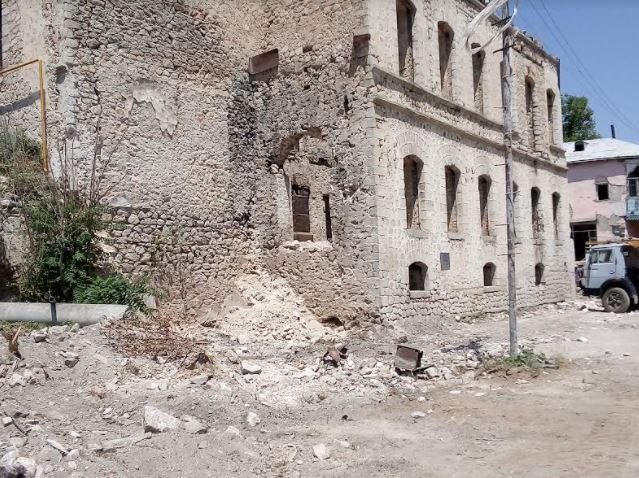By Rachel Avraham
On March 31, Azerbaijanis across the world commemorate Azerbaijani Genocide Day in memory of the 10,068 innocent Azerbaijani men, women and children who were slaughtered in 1918 by Armenian terrorists and the 50,000 others who would become refugees during that period of time. As Thoams Da Waal wrote in Black Garden, “The Azerbaijanis people, who had lived in” the region “for centuries, had become its silent guests, marginalized and discriminated against. The Armenians asserted their right to their homeland at the expense of these people.”
“When one speaks of the streets of a town running with blood,” said one British political officer, “one is generally employing a figure of speech. But if one is referring to Baku between 1917 and 1919, one is being starkly literal.” According to Da Waal, “A group of mainly Armenian commissars took over the city and formed the Baku Commune, a small Bolshevik bridgehead in an otherwise anti-Bolshevik Caucasus. When in March 1918 Azerbaijanis revolted against the Baku Commune, Armenian Dashnaks and Bolshevik troops poured into the Azerbaijani quarters of the city and slaughtered thousands.”
As the famous historian Justin McCarthy recounted in Death and Exile: Ethnic cleansing of Ottoman Muslims, 1821-1922: “Between March 30 and April 1, 1918, the Tatars (Azerbaijanis) were attacked. Almost half of the Muslim population of Baku was forced to flee the city. In that period between 8,000 and 12,000 Muslims were killed in Baku alone.”
The genocide began in Baku but spread to other areas of Azerbaijan, such as Shamakhi, Guba, Karabakh, Zangezur, Goycha, Nakhchivan, Salyan and Lankara. In 1918–1920, tens of thousands of Azerbaijanis were expelled from Zangezur. Across Azerbaijan, civilians were slaughtered, villages were burned down and any cultural and historical sites that were connected to Azerbaijan were destroyed. They even demolished mosques and cemeteries. The Armenians destroyed a total of 197 villages, slaughtering and expelling local residents while looting their property and razing their homes to the ground. According to Emil Soleimanov, a Czech political scientist, “Karabakh lost one fifth of its population.”
According to Firuz Kazimzadeh, a professor at Yale University “The truth is that the Armenians, under the guise of Bolshevism, rushed on the Muslims and massacred during a few frightful days more than 12,000 people, many of whom were old men, women, and children. The March events, as this episode became known in history, led to the emergence of a whole series of killings of Azerbaijanis. The atrocities continued throughout the week. Every Azerbaijani, whom Dashnak [Armenian nationalist forces] gangs could catch, was killed.”
Gunler, a German witness of these tragic events, wrote in his memoirs: “The Armenians attacked Muslim settlements, killing everybody, cutting them up with swords and bayoneting. Several days after the genocide, the corpses of 87 Azerbaijanis were pulled out from a grave. Their ears and noses were cut off, their abdominals were ripped up and genitals chopped off. The Armenians showed no mercy to the children and elderly people.”
It is critical to recall that the Armenians did not stop at killing Azerbaijani Muslims during this period of time. Over 3,000 Mountain Jews, who have been living in Guba for over 1,500 years, were massacred by the Armenians alongside Azerbaijani Muslims. The death toll in Guba researched almost 20,000, of which 16,000 were Muslim Azerbaijanis.
Several years ago, I published a book titled Women and Jihad, where I documented how the Armenians were among the first groups to employ ethno-nationalist terrorism in their struggle against continued Ottoman rule: “During this period, Armenian nationalists led by the Dashnaks and Hunchaks pursued armed struggle in order to try to establish an independent Armenian state.” Inspired by the idea of a Greater Armenia, they took advantage of the Bolshevik Revolution to wage a genocide in order to obtain their political aspirations.
Prominent political scientist Guenter Lewey recounted: “The Hunchaks embraced political terror as a means of eliminating opponents, spies and informers. Article 6 of the Program of the Hunchak Party stated: ‘The time for general revolution in Armenia will be when a foreign power attacks Turkey externally. The party shall revolt internally.’” The Hunchak Program included “arming the people, sabotage, execution of government officials as well as Armenian traitors and so forth.”
McCarthy stressed: “The basic principles of Mao Tse-Tung of China, General Vo Nguyen Giap in Vietnam and Fidel Castra in Cuba bear striking similarities to those of the Dashnaktsutiun in Anatalia.” In my book, I noted: “Their tactics were a precursor to later separatist groups in the post-World War II era.” Indeed, ASALA and the instigators of the Khojaly Genocide learned much from these Armenian groups how to wage terror attacks.
In July 2007, Azerbaijani academics began extensive research on the mass grave from this period in Guba, which was completed in September 2008. The research has discovered the remains of more than 400 people belonging to different age groups in the mass grave. Of these, 50 belong to children, more than 100 to women and others mainly to elderly men. It has been established that along with Azerbaijanis the mass grave contains the remains of brutally murdered Lezghins, Jews, Tats and other ethnic groups living in Guba. A genocide memorial in Guba was built on this location by the Azerbaijani government in memory of this grave crime against humanity that occurred in 1918.





